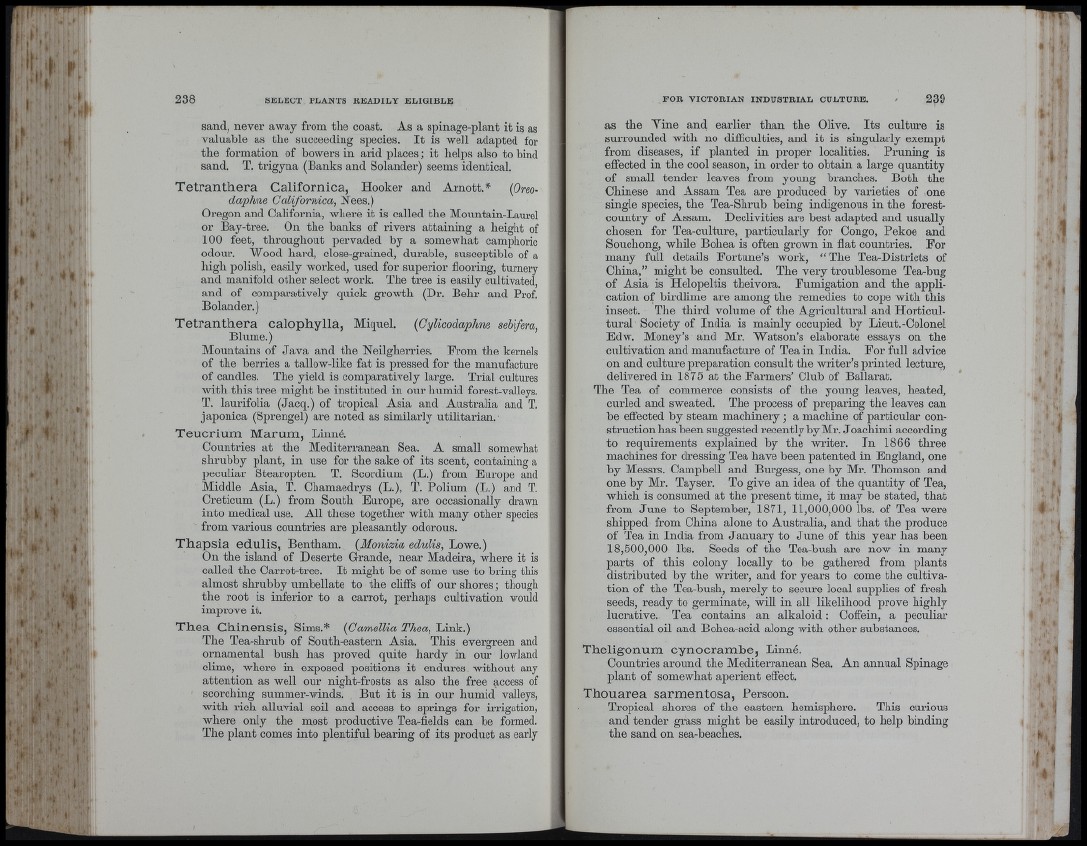
ì r t lp . ft ■
■ i
238 SELECT PLANTS READILY ELIGIBLE
sand, nevex’ away fx-oxxx the coast. As a spinage-plant it is as
valixable as the sxxcceedixig species. I t is well adapted for
the fox-mation of bowex’s in arid places; it helps also to bind
sand. T. trigyna (Banks axxd Solaxxder) seems identical.
Tetranthera Californica, Hooker and Ax-nott.* {Oreodaphne
Californica, Nees.)
Ox’egon and California, where it is called the Moxxntain-Laurel
or Bay-tree. Oxx the baxxks of rivers attaining a height of
100 feet, throughout pervaded by a somewhat camphoric
odour. Wood hard, close-grained, durable, sxxsceptible of a
high polish, easily wox’ked, used for supex'ior flooring, tux’nery
axxd manifold other select work. The tree is easily cultivated,
and of comparatively quick growth (Dr. Behr axxd Prof.
Bolander.)
Tetranthera calophylla, Miquel. {Gylicodaphne sehifera,
Blxxxne.)
Mountaixxs of Java and the Neilgherxies. From the kernels
of the berries a tallow-like fat is pressed for tbe maxxufacture
of candles. The yield is comparatively large. Txial cultures
with this tree xniglxt be ixxstituted ixx our humid forest-valleys.
T. laurifolia (Jacq.) of tropical Asia and Axxstralia axxd T.
japonica (Sprengel) are noted as similaxdy utilitarian.
Teucrium Marum, Lixmé.
Couxxtries at the Mediterranean Sea. A small somewhat
shrubby plant, in use for the sake of its scent, coxxtainixxg a
peculiar Stearopten. T. Scordium (L.) from Europe and
Middle Asia, T. Cbamaedrys (L.), T. Polium (L.) and T.
Creticum (L.) from South Europe, are occasionally drawn
into medical use. All these together with many other species
from various countries are pleasantly odorous.
Thapsia edulis, Bentham. {Monizia edulis, Lowe.)
Oxx the island of Deserte Grande, near Madeira, where it is
called the Carrot-tree. I t might be of some use to bxing this
almost shrixbby xxmbellate to the cliffs of our shores; though
the root is ixxfexior to a carrot, perhaps cultivatioxx would
improve it.
Thea Chinensis, Sims.* {Camellia Thea, Link.)
The Tea-shrnb of South-eastern Asia. This evergreeix and
ornamental bush has proved quite hardy in onr loxvland
clime, where in exposed positions it endures without axxy
attexxtion as well our ixight-frosts as also the free access of
scorching sxxxnmer-winds. But it is in oxxr humid valleys,
with rich alluvial soil axxd access to springs for irrigation,
where only the most productive Tea-fields can be formed.
The plant comes into plentiful bearing of its product as early
FOR VICTORIAN INDUSTRIAL CULTURE. 239
as the Vine and earlier than the Olive. Its culture is
surromided with no difficulties, and it is singulaxly exempt
from diseases, if planted ixx proper localities. Pruning is
effected in the cool season, ixx order to obtain a large quantity
of small tender leaves from young branches. Both the
Chinese and Assam Tea are produced by varieties of one
single species, the Tea-Shrub being indigenous in the forest-
country of Assam. Declivities are best adapted and usually
chosen for Tea-cultxxre, particularly for Congo, Pekoe and
Souchong, while Bolxea is oftexi grown in flat countxies. For
many full details Fortune’s work, “ Tbe Tea-Districts of
China,” might be consulted. Tbe vexy troublesome Tea-bug
of Asia is Helopeltis theivora. Fumigation and the application
of birdlime are among the remedies to cope with this
insect. The third volume of the Agxlcultural and Horticultural
Society of India is mainly occupied hy Lieut.-Colonel
Edw. Money’s and Mr. Watson’s elaborate essays on the
cultivatioxx and manufactxxre of Tea in India. For fxxll advice
on and culture preparation consult the writer’s prixxted lecture,
delivered ixx 1875 at the Farmers’ Club of Ballarat.
The Tea of coxnmerce consists of the youxxg leaves, heated,
cixx'led axxd sweated. The process of preparing the leaves can
he effected by steam machinery ; a machine of particular construction
has been suggested recexxtly by Mr. Joachimi according
to requix’emexxts explaixxed by tbe writer. Ixx 1866 three
machines for dressing Tea have been patented in England, one
by Messrs. Campbell and Burgess, oxxe by Mr. Thomson and
one by Mr. Tayser. To give an idea of the quaxxtity of Tea,
which is consxxmed at the present time, it may be stated, that
from June to September, 1871, 11,000,000 lbs. of Tea were
shipped from China alone to Australia, and that the produce
of Tea in India from January to June of this year has heen
18,500,000 lbs. Seeds of the Tea-bush are now ixx many
parts of this colony locally to be gathered froxxx plants
distributed by tbe writer, and for years to come the cixltiva-
tion of tbe Tea-bush, mex’ely to secxxx’e local supplies of fx-eslx
seeds, ready to germinate, will in all likelihood prove highly
lucrative. Tea contains an alkaloid ; Coffein, a peculiar
essential oil and Bobea-acid aloxxg with other substaxxces.
Theligonum cynocrambe, Linné.
Couxxtries around the Mediterranean Sea. An axxnixal Spinage
plant of somewhat aperient effect.
Thouarea sarmentosa, Persoon.
Tropical shores of the eastern hemisjxhere. This curious
and tender grass might be easily introduced, to help bindixxg
the sand on sea-beaches.